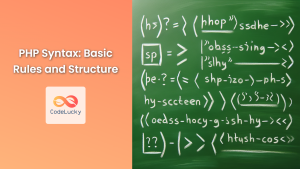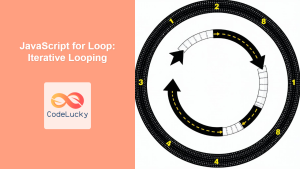In the world of PHP programming, loops are essential constructs that allow developers to execute a block of code repeatedly. Among these, the for loop stands out as a powerful and versatile tool for counter-based iteration. This article will dive deep into the intricacies of PHP's for loop, exploring its syntax, use cases, and best practices.
Understanding the For Loop Syntax
The for loop in PHP follows a specific structure:
for (initialization; condition; increment/decrement) {
// Code to be executed
}
Let's break down each component:
- Initialization: This is where you set up your loop variable, typically a counter.
- Condition: The loop continues as long as this condition is true.
- Increment/Decrement: This is executed at the end of each iteration, usually to update the counter.
🔍 Pro Tip: The semicolons separating these components are crucial. Omitting them will result in a syntax error.
A Simple For Loop Example
Let's start with a basic example to illustrate how a for loop works:
<?php
for ($i = 1; $i <= 5; $i++) {
echo "Iteration number: $i<br>";
}
?>
Output:
Iteration number: 1
Iteration number: 2
Iteration number: 3
Iteration number: 4
Iteration number: 5
In this example, we:
- Initialize
$ito 1 - Continue the loop as long as
$iis less than or equal to 5 - Increment
$iby 1 after each iteration
🎨 CodeLucky Insight: Visualize the loop as a carousel. Each rotation (iteration) brings a new horse (value) into view until the ride (condition) is complete.
Customizing the Counter
One of the beauties of the for loop is its flexibility. You're not limited to incrementing by 1 each time. Let's look at an example where we count by twos:
<?php
for ($i = 0; $i <= 10; $i += 2) {
echo "Even number: $i<br>";
}
?>
Output:
Even number: 0
Even number: 2
Even number: 4
Even number: 6
Even number: 8
Even number: 10
Here, we're using $i += 2 to increment our counter by 2 in each iteration, effectively printing even numbers from 0 to 10.
Nested For Loops
For loops can be nested within each other, allowing for more complex iterations. Let's create a simple multiplication table using nested for loops:
<?php
echo "<table border='1'>";
for ($i = 1; $i <= 5; $i++) {
echo "<tr>";
for ($j = 1; $j <= 5; $j++) {
echo "<td>" . ($i * $j) . "</td>";
}
echo "</tr>";
}
echo "</table>";
?>
This will produce a 5×5 multiplication table:
| 1 | 2 | 3 | 4 | 5 |
|---|---|---|---|---|
| 2 | 4 | 6 | 8 | 10 |
| 3 | 6 | 9 | 12 | 15 |
| 4 | 8 | 12 | 16 | 20 |
| 5 | 10 | 15 | 20 | 25 |
🏆 CodeLucky Challenge: Try extending this table to 10×10. Can you add row and column headers?
Iterating Over Arrays with For Loops
While foreach is often preferred for array iteration, for loops can be used effectively, especially when you need more control over the iteration process.
<?php
$fruits = ["Apple", "Banana", "Cherry", "Date", "Elderberry"];
for ($i = 0; $i < count($fruits); $i++) {
echo "Fruit " . ($i + 1) . ": " . $fruits[$i] . "<br>";
}
?>
Output:
Fruit 1: Apple
Fruit 2: Banana
Fruit 3: Cherry
Fruit 4: Date
Fruit 5: Elderberry
🍎 CodeLucky Tip: When iterating over arrays, always ensure your loop condition prevents going beyond the array's bounds to avoid "Undefined offset" errors.
Reverse Iteration
For loops aren't limited to counting up. We can easily create a countdown by adjusting our initialization, condition, and decrement:
<?php
for ($i = 5; $i > 0; $i--) {
echo "Countdown: $i<br>";
}
echo "Blast off! 🚀";
?>
Output:
Countdown: 5
Countdown: 4
Countdown: 3
Countdown: 2
Countdown: 1
Blast off! 🚀
Multiple Expressions in For Loop Components
Each component of the for loop can actually contain multiple expressions separated by commas. This can be useful for more complex iterations:
<?php
for ($i = 0, $j = 5; $i < 5; $i++, $j--) {
echo "i: $i, j: $j<br>";
}
?>
Output:
i: 0, j: 5
i: 1, j: 4
i: 2, j: 3
i: 3, j: 2
i: 4, j: 1
In this example, we initialize and update two variables simultaneously within the same loop.
Omitting For Loop Components
Interestingly, you can omit any of the three main components of a for loop, as long as you ensure the loop will terminate:
<?php
$i = 0;
for (; $i < 5; $i++) {
echo "$i ";
}
echo "<br>";
for ($i = 0; $i < 5;) {
echo "$i ";
$i++;
}
echo "<br>";
$i = 0;
for (;;) {
if ($i >= 5) {
break;
}
echo "$i ";
$i++;
}
?>
Output:
0 1 2 3 4
0 1 2 3 4
0 1 2 3 4
🎭 CodeLucky Drama: Imagine each component of the for loop as an actor. Sometimes, one might not show up, but the show must go on!
Performance Considerations
When working with large datasets or performance-critical code, consider these optimizations:
- Cache the array length: Instead of calling
count()in each iteration, store it in a variable.
<?php
$fruits = ["Apple", "Banana", "Cherry", "Date", "Elderberry"];
$fruitCount = count($fruits);
for ($i = 0; $i < $fruitCount; $i++) {
echo $fruits[$i] . "<br>";
}
?>
- Unset variables after the loop: If you're not using the loop variable afterwards, unset it to free up memory.
<?php
for ($i = 0; $i < 1000000; $i++) {
// Some intensive operation
}
unset($i);
?>
Common Pitfalls and How to Avoid Them
- Infinite Loops: Always ensure your loop condition will eventually become false.
<?php
// Incorrect - Infinite loop
for ($i = 0; $i >= 0; $i++) {
echo $i; // This will run forever!
}
// Correct
for ($i = 0; $i < 10; $i++) {
echo $i;
}
?>
- Off-by-One Errors: Be careful with your loop conditions, especially when working with array indices.
<?php
$arr = [1, 2, 3, 4, 5];
// Incorrect - Will cause an "Undefined offset" error
for ($i = 0; $i <= count($arr); $i++) {
echo $arr[$i];
}
// Correct
for ($i = 0; $i < count($arr); $i++) {
echo $arr[$i];
}
?>
🐞 CodeLucky Debug: Think of off-by-one errors as trying to sit in a chair that isn't there. Always double-check your loop boundaries!
Creative Uses of For Loops
Let's explore some unique applications of for loops:
Generating a Fibonacci Sequence
<?php
$n = 10; // Number of Fibonacci numbers to generate
$fib = [0, 1]; // Initialize with first two numbers
for ($i = 2; $i < $n; $i++) {
$fib[$i] = $fib[$i-1] + $fib[$i-2];
}
echo "First $n Fibonacci numbers: " . implode(", ", $fib);
?>
Output:
First 10 Fibonacci numbers: 0, 1, 1, 2, 3, 5, 8, 13, 21, 34
Creating a Diamond Pattern
<?php
$size = 5;
// Upper half of the diamond
for ($i = 1; $i <= $size; $i++) {
for ($j = $size; $j > $i; $j--) {
echo " ";
}
for ($k = 1; $k <= $i * 2 - 1; $k++) {
echo "*";
}
echo "<br>";
}
// Lower half of the diamond
for ($i = $size - 1; $i >= 1; $i--) {
for ($j = $size; $j > $i; $j--) {
echo " ";
}
for ($k = 1; $k <= $i * 2 - 1; $k++) {
echo "*";
}
echo "<br>";
}
?>
Output:
*
***
*****
*******
*********
*******
*****
***
*
🌟 CodeLucky Creativity: Loops are like digital paintbrushes. With the right strokes (iterations), you can create beautiful patterns!
Conclusion
The for loop is a fundamental construct in PHP that offers great flexibility and control in iterative processes. From simple counters to complex nested iterations, mastering the for loop opens up a world of possibilities in PHP programming.
Remember, while for loops are powerful, they're not always the best choice. For simple array iterations, foreach might be more readable. Always consider the specific needs of your project when choosing your loop structure.
Keep practicing with different loop scenarios, and soon you'll find yourself looping through PHP code with ease and confidence!
🚀 CodeLucky Challenge: Try creating a program that uses a for loop to generate a Pascal's triangle. How would you approach this problem?
Happy coding, and may your loops always terminate!
- Understanding the For Loop Syntax
- A Simple For Loop Example
- Customizing the Counter
- Nested For Loops
- Iterating Over Arrays with For Loops
- Reverse Iteration
- Multiple Expressions in For Loop Components
- Omitting For Loop Components
- Performance Considerations
- Common Pitfalls and How to Avoid Them
- Creative Uses of For Loops
- Conclusion


















